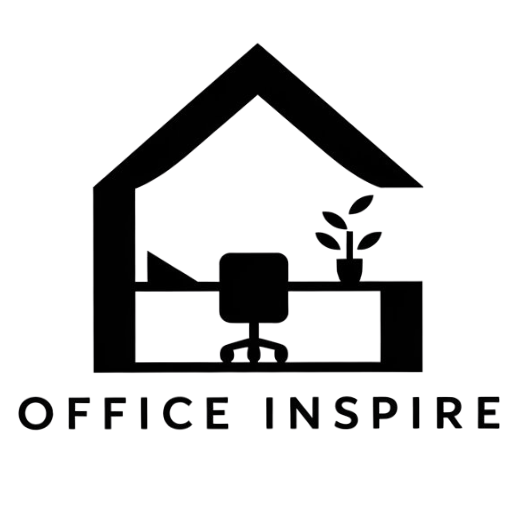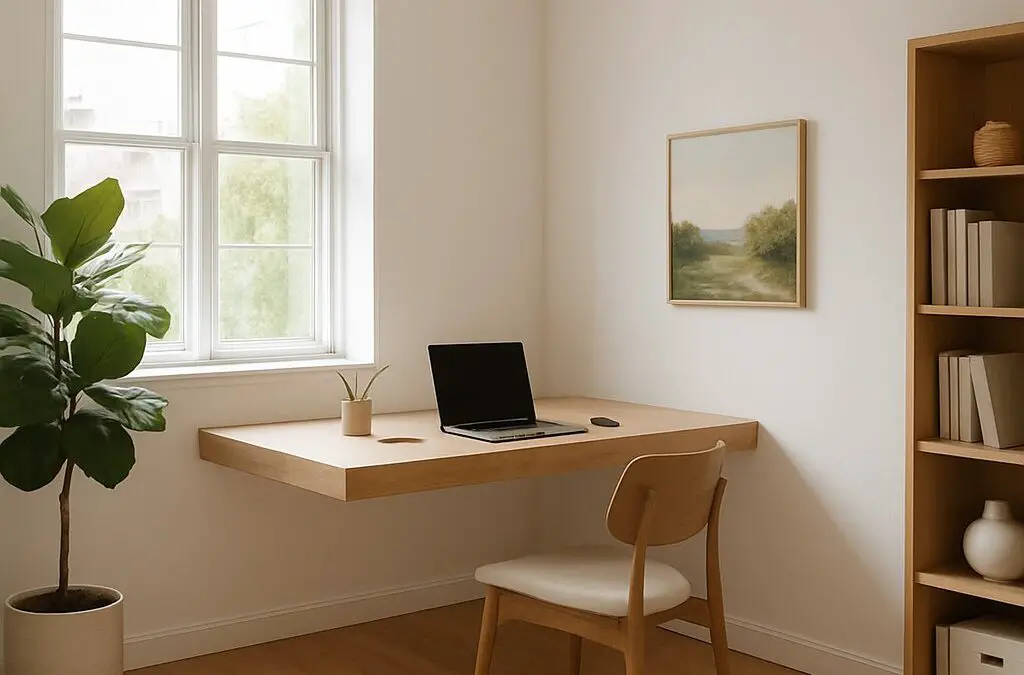Minimalism and coziness might seem like opposing concepts at first glance—one emphasizing simplicity and restraint, the other warmth and comfort—but when thoughtfully combined, they create the ultimate productive and welcoming home office environment. Cozy minimalism proves you don’t need clutter, excessive decoration, or maximalist abundance to create a workspace that feels inviting, personal, and genuinely comfortable for long working hours.
Instead, this design philosophy focuses on careful selection of quality pieces, intentional use of warm materials and textures, and creating visual calm through simplified aesthetics that reduce mental noise and promote deep focus. The result is a home office that feels like a peaceful sanctuary rather than a sterile showroom, balancing the psychological benefits of minimalist clarity with the emotional comfort of cozy warmth.
In this comprehensive guide, we’ll explore 27 inspiring cozy minimalist home office ideas that prove less really can be more when every element is chosen with intention, quality, and purpose.
1. All-White Office with Single Wood Accent

Create a serene, light-filled workspace with all-white walls, a single natural wood desk, and just one carefully selected plant, proving that simplicity creates its own form of elegance. This pared-down approach eliminates visual distractions and creates a blank canvas that allows your mind to focus entirely on work rather than processing unnecessary environmental stimuli. The warmth of natural wood prevents the white space from feeling cold or clinical, while the living plant adds essential organic life and improves air quality without creating clutter or visual complexity.
All-white interiors maximize light reflection, making even small spaces feel significantly larger, brighter, and more open than they actually are—a valuable optical illusion in compact home offices. The clean simplicity makes the space incredibly easy to maintain and keep organized, as anything out of place becomes immediately obvious against the neutral backdrop. This approach works particularly well in naturally bright spaces where abundant light brings out subtle variations in white tones and prevents the space from feeling flat or one-dimensional.
PRO TIP: Layer multiple shades of white—pure white, cream, ivory, off-white—rather than using a single stark white throughout. These subtle variations create depth and visual interest while maintaining the cohesive, monochromatic aesthetic that makes this approach so calming and effective.
2. Beige and Cream Neutral Tones Office
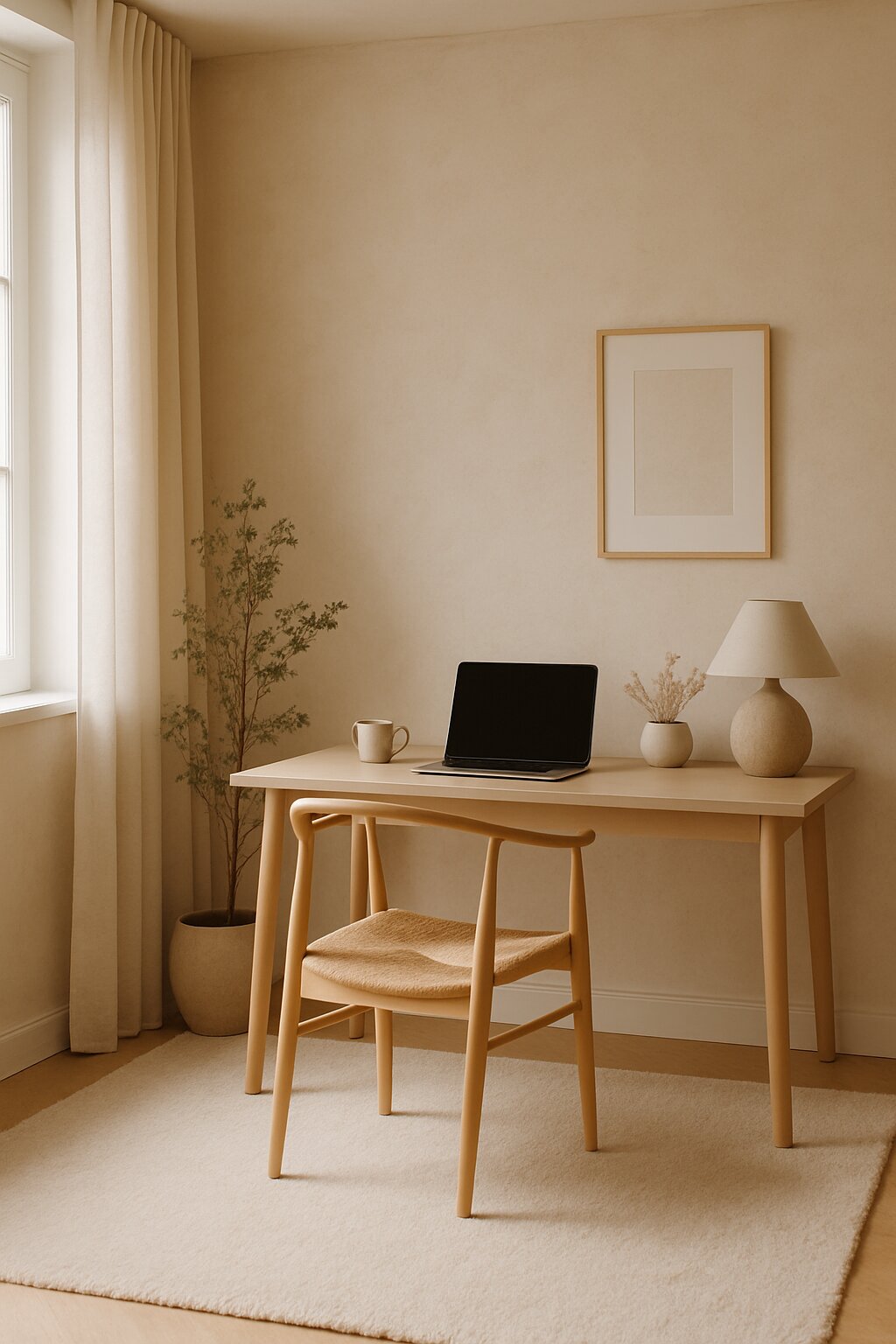
Embrace the warmth of a beige and cream color palette that creates a soft, inviting minimal workspace without the starkness sometimes associated with pure white minimalism. These warm neutral tones provide psychological comfort and coziness while maintaining the visual simplicity and clutter-free aesthetic central to minimalist design philosophy. The subtle variation between beige walls, cream textiles, and natural wood creates gentle contrast and dimension without introducing competing colors that fragment attention.
Neutral tones create a timeless backdrop that won’t feel dated in five or ten years, unlike trendy colors that quickly age and feel passé. This palette works beautifully with natural light throughout the day, appearing warmer and more golden in morning light and softer and cooler in afternoon shadows. Add texture through natural materials—linen, wool, cotton, jute—to prevent the neutral scheme from feeling flat or boring while maintaining the calm, understated aesthetic.
PRO TIP: Sample multiple beige and cream paint colors on your walls before committing, as these neutral tones can look dramatically different depending on your specific lighting conditions, surrounding colors, and time of day. What appears perfect in the paint store may read too yellow, pink, or gray in your actual space.
3. Japanese Wabi-Sabi Minimalist Office
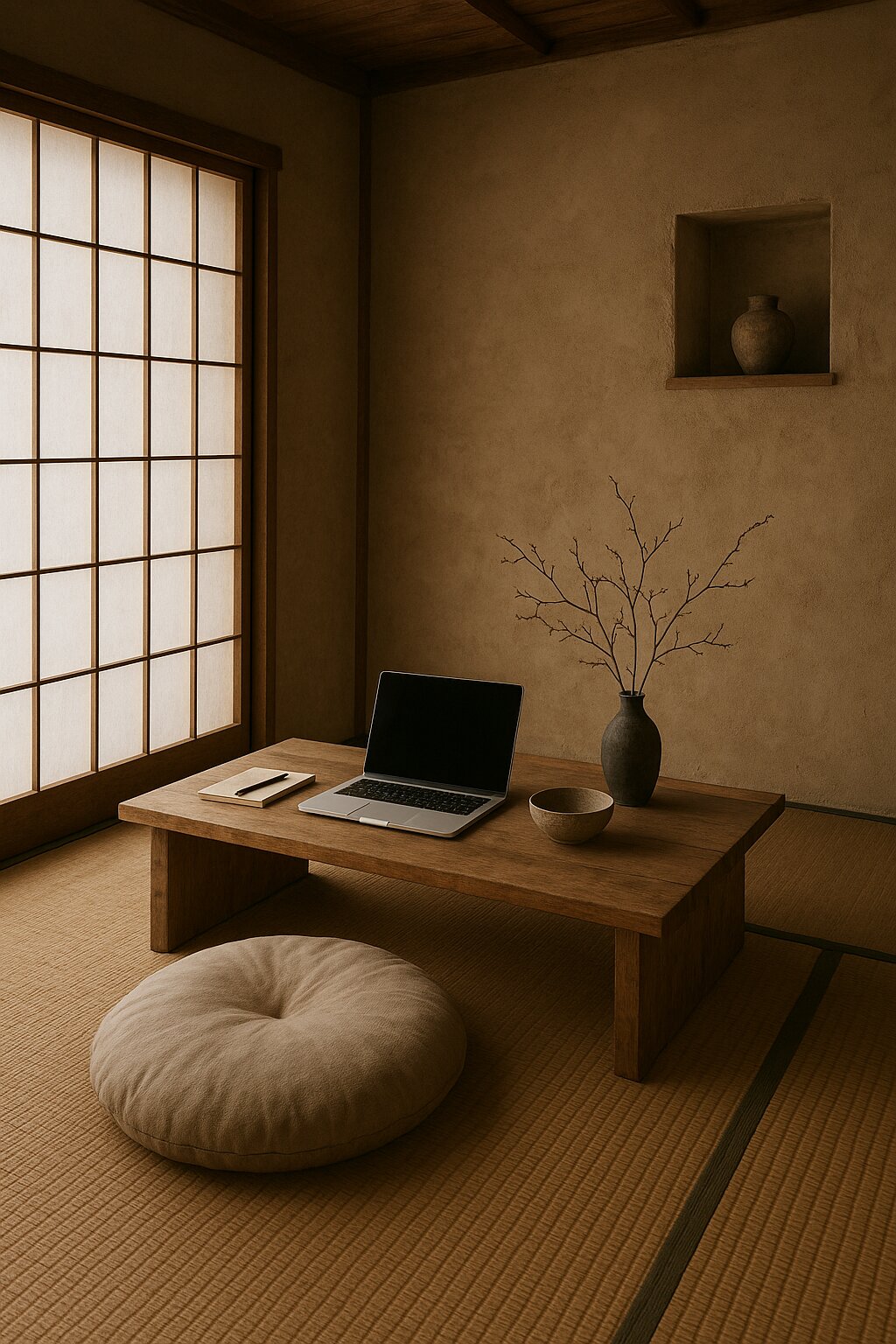
Embrace the Japanese philosophy of wabi-sabi by creating a minimalist office that celebrates imperfection, impermanence, and the authentic beauty of natural materials as they age and develop patina. This approach values handmade objects with visible craft, natural materials showing wear, and the serene beauty of simplicity rather than pursuing flawless perfection. A low wooden desk with visible grain and perhaps natural edge, handmade ceramic accessories, and deliberately unmatched elements create a space that feels peaceful, grounded, and genuinely authentic.
Wabi-sabi teaches us to find beauty in things as they truly are rather than constantly seeking idealized perfection—a valuable perspective when creating a workspace meant for daily use rather than photoshoots. The emphasis on natural materials aging gracefully reduces anxiety about keeping everything pristine and perfect, allowing you to actually use and enjoy your workspace without constant worry about maintaining showroom condition. This philosophy encourages mindful, intentional living and working that reduces stress and promotes presence in the current moment.
PRO TIP: Source vintage or handmade items with slight imperfections, visible repairs, or natural irregularities rather than seeking mass-produced perfection. These authentic pieces embody wabi-sabi principles while adding character and story that generic items lack, creating a space that feels personally meaningful rather than generically minimalist.
4. Gray and White with Concrete Accents

Bridge industrial and minimalist aesthetics with a gray and white color palette featuring concrete wall accents, modern minimal furniture, and a sophisticated urban atmosphere. This contemporary approach brings the raw, honest quality of industrial materials into a refined minimalist framework, creating spaces that feel both edgy and composed. Concrete provides interesting texture and visual weight that prevents all-white minimalism from feeling too ethereal or disconnected from physical reality.
The cool gray tones create a calming, focused environment perfect for concentration work, while the industrial materials add masculine edge and contemporary relevance. This palette works exceptionally well in loft-style spaces, converted industrial buildings, or anywhere you want to acknowledge architectural honesty and material authenticity. Soften the potentially cold feeling of gray and concrete with warm wood furniture, soft textile throws, and strategic lighting that adds warmth without introducing unnecessary color.
PRO TIP: Use concrete as an accent wall or desktop surface rather than covering entire rooms—the material’s visual and physical weight can become overwhelming in large quantities. Strategic placement provides impact and interest while maintaining balance with softer materials and lighter colors elsewhere in the space.
5. Scandinavian Hygge Minimalist Office

Combine Scandinavian design principles with Danish hygge coziness to create the perfect balance of minimalist clarity and warm comfort. This approach includes simple wooden furniture with clean lines, soft throw blankets in natural fibers, plenty of candles (real or LED), and the intentional creation of cozy moments within minimal surroundings. The Scandinavian aesthetic values function, natural materials, and connection to nature, while hygge emphasizes comfort, contentment, and those small pleasures that make life worth living.
Incorporate classic Scandinavian elements like light wood finishes, white and gray color palettes, functional storage that disappears when not needed, and abundant natural light maximized through minimal window treatments. Layer in hygge elements like soft wool blankets, sheepskin throws, multiple light sources creating warm pools of illumination, and perhaps a comfortable reading chair for taking contemplative breaks. The combination creates a workspace that supports both productive work and genuine well-being.
PRO TIP: Create a daily hygge ritual within your minimalist office—light a candle each morning as you begin work, take afternoon tea breaks with a special mug you love, or end your workday by wrapping yourself in a soft blanket while reviewing tomorrow’s priorities. These intentional comfort rituals provide psychological transition points and moments of pleasure within your workday.
6. Floating Wall-Mounted Desk Minimal

Maximize floor space and visual lightness with a floating wall-mounted desk that appears to hover weightlessly, creating the ultimate streamlined, clutter-free workspace. This space-saving solution eliminates bulky desk legs and creates open floor area that makes rooms feel significantly more spacious and airy. The clean lines and minimal visual weight appeal to minimalist sensibilities while the practical efficiency makes small spaces function better than traditional furniture would allow.
Wall-mounted desks force mindful minimalism because limited surface area simply won’t accommodate clutter or excessive belongings—everything you keep must truly earn its place through regular use or genuine importance. This built-in constraint naturally enforces the minimalist principle of keeping only what adds value. Mount the desk at precisely the right height for ergonomic comfort to ensure this beautiful minimal solution doesn’t sacrifice physical well-being for aesthetic appeal.
PRO TIP: Install your floating desk at standard desk height (28-30 inches) unless you have specific ergonomic needs, and ensure it’s properly anchored into wall studs to support equipment weight and work surface pressure. A beautiful floating desk becomes useless if it’s uncomfortable to work at or structurally unstable.
7. Warm Wood Tones Throughout
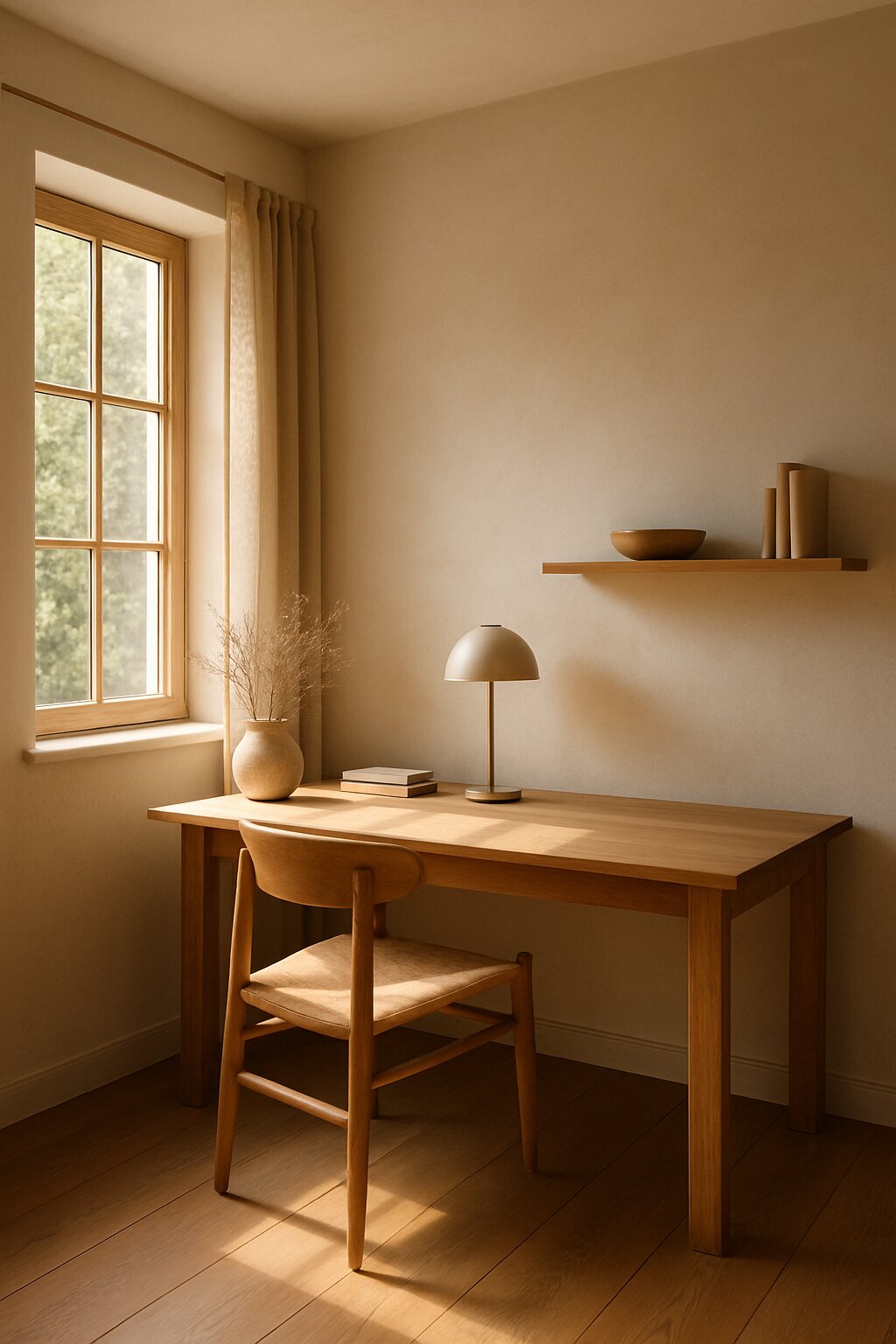
Create an inviting, organic minimalist office by featuring warm wood tones throughout—desk, shelving, flooring, and accessories—that bring natural warmth without introducing color or pattern complexity. This approach proves minimalism doesn’t have to mean cold, sterile, or uncomfortable; instead, natural materials provide inherent visual interest through grain patterns, color variations, and organic imperfections that mass-produced items lack. The warmth of wood creates psychological comfort and connection to nature even in urban settings.
Different wood species and finishes provide subtle variation within the natural material family—light ash or oak versus richer walnut or teak—allowing you to create depth and dimension while maintaining cohesive minimalist simplicity. Wood’s natural beauty means it requires minimal styling or accessorizing to look complete and intentional, supporting the minimalist goal of reducing unnecessary objects. The tactile quality and warmth of wood also make your workspace more pleasant to touch and interact with compared to cold metal or plastic alternatives.
PRO TIP: Mix different wood tones and finishes rather than trying to match everything perfectly—varied woods create depth and collected-over-time authenticity that perfectly matched sets lack. The key is ensuring all woods share either warm (golden/red) or cool (gray/ash) undertones so they harmonize despite not matching exactly.
8. Black and White Monochrome Minimalism
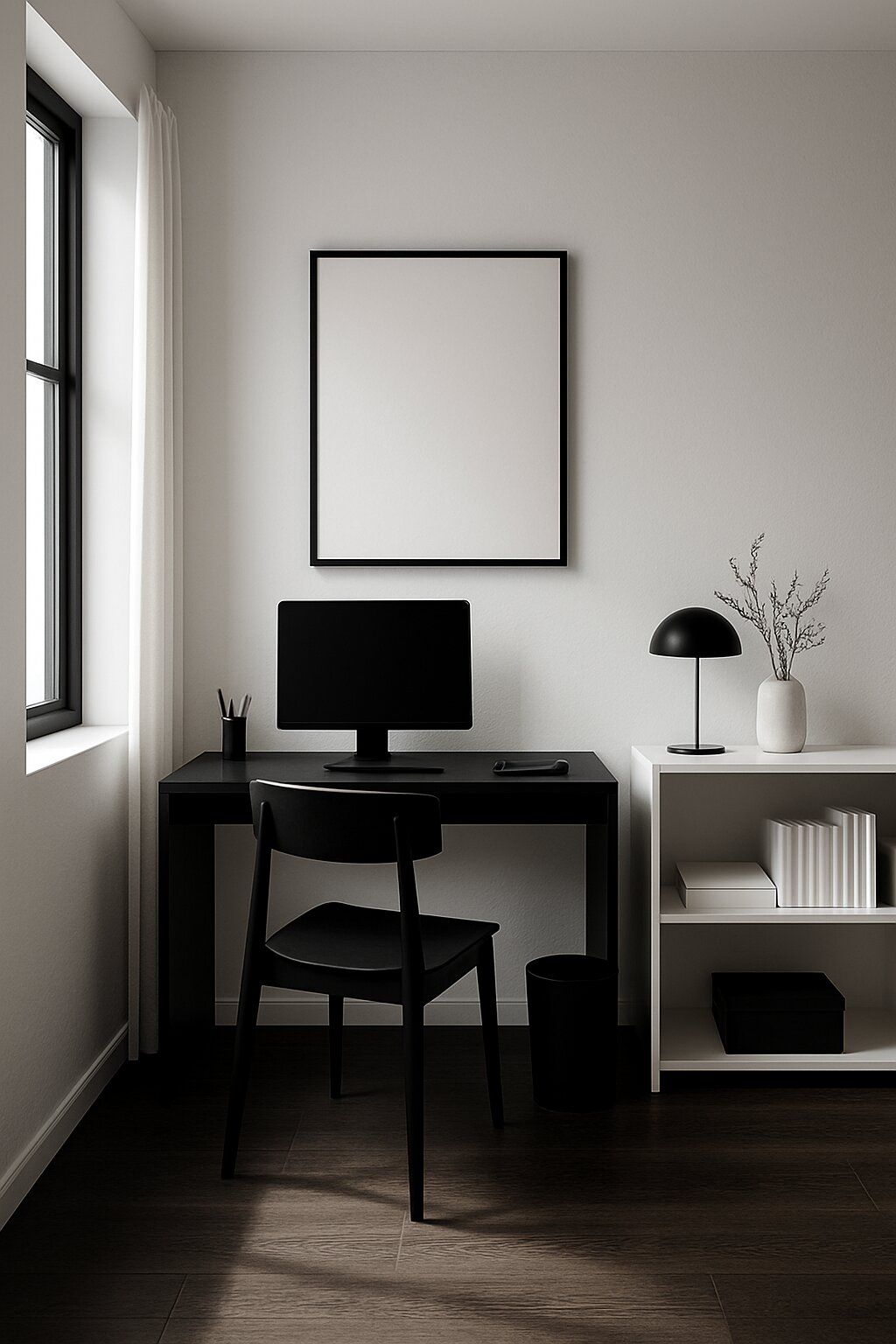
Make a bold statement with high-contrast black and white monochrome minimalism that creates graphic impact through stark simplicity. This dramatic approach uses the strongest possible contrast—pure black against pure white—to create spaces that feel modern, sophisticated, and unapologetically minimal. Simple geometric furniture with clean lines looks particularly striking in this palette, as the forms read clearly without color distraction.
The black and white scheme creates inherent visual drama that prevents minimalism from feeling boring or under-designed, proving that simple doesn’t have to mean plain. This palette also photographs incredibly well, creating striking images perfect for social media or professional portfolios. The key to making monochrome work without feeling harsh is incorporating varied textures—matte and glossy blacks, warm and cool whites—that add subtle complexity while maintaining the graphic simplicity.
PRO TIP: Add warmth to black and white minimalism through lighting temperature and natural materials rather than introducing color. Warm-toned light bulbs, natural wood accents, and organic textures prevent the stark palette from feeling cold or institutional while maintaining the monochromatic aesthetic.
9. Single Statement Plant as Focal Point
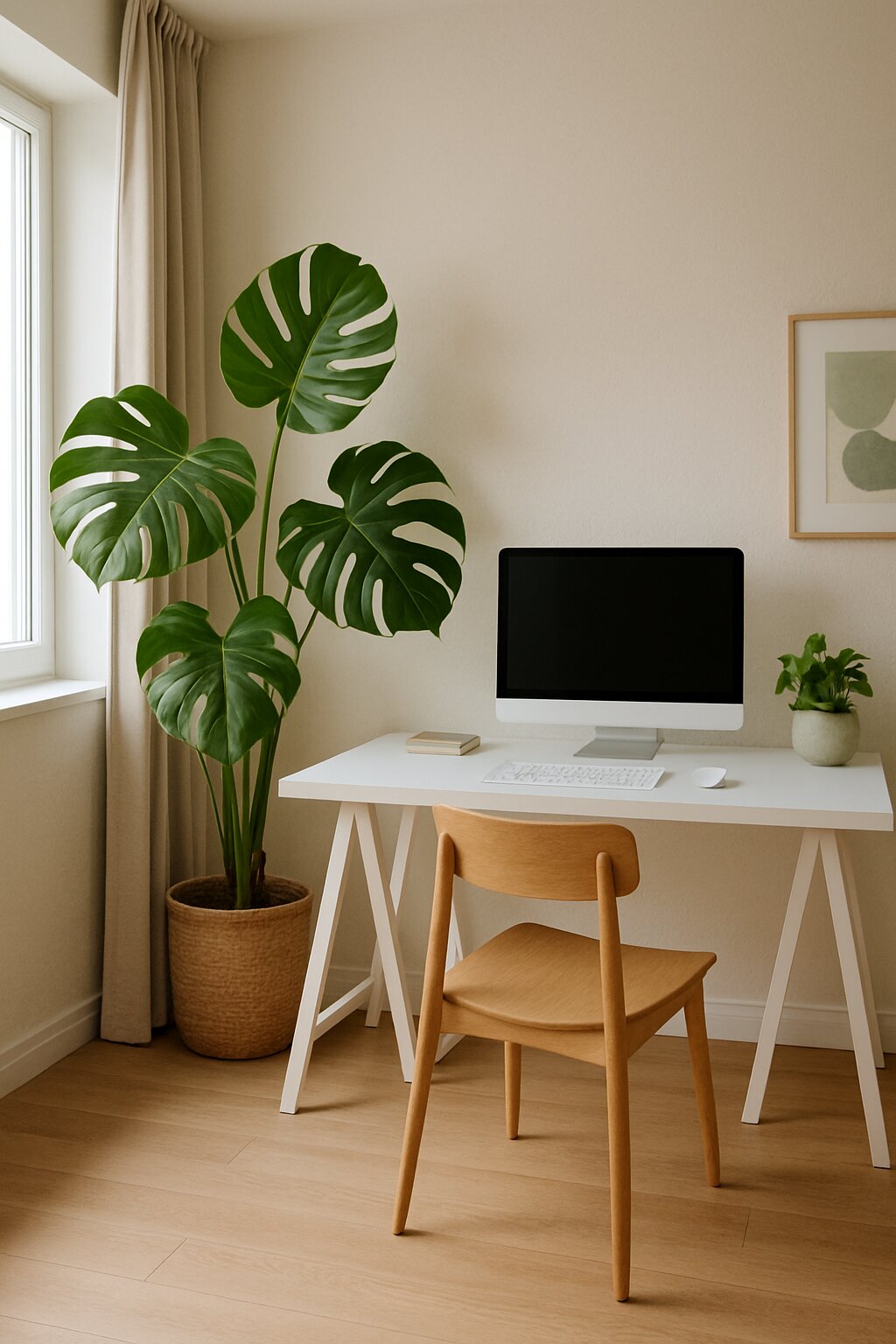
Let one large, architecturally interesting plant serve as your office’s primary decorative element and living focal point, proving that minimalism embraces nature’s beauty while rejecting unnecessary objects. This approach features a substantial plant—perhaps a fiddle leaf fig, monstera, bird of paradise, or dramatic palm—that provides visual impact, improves air quality, and adds essential life and organic movement to minimal spaces. The green of living plants provides color that feels natural and calming rather than arbitrary or distracting.
A single statement plant requires no additional decoration or styling to create visual interest and personality in your workspace, perfectly embodying minimalist principles of simplicity and intention. The care and attention required to maintain a healthy plant also creates mindful breaks throughout your workday and connects you to natural rhythms beyond your work demands. Position your plant where natural light supports its growth while also placing it prominently in your field of vision to maximize its psychological benefits.
PRO TIP: Research your chosen plant’s specific light, water, and humidity requirements before committing to ensure you can actually maintain it successfully in your space. A dying, struggling plant creates stress and guilt rather than the calm, life-affirming presence a thriving plant provides in minimalist spaces.
10. Earth Tones: Terracotta and Sage

Bring warmth and organic beauty to minimalist design with an earth-tone palette of terracotta orange and sage green that feels grounded, natural, and deeply calming. These warm, muted tones connect your workspace to nature’s color story—the clay of earth and the green of living plants—creating psychological associations with stability, growth, and organic life. The combination feels both modern and timeless, avoiding trendy colors that quickly date while still feeling fresh and current.
Terracotta clay pottery, sage green textiles, and natural wood create a cohesive material story that reinforces the earth-connected aesthetic. This palette works beautifully in spaces with abundant natural light where the colors shift throughout the day—appearing warmer and more saturated in direct sun, softer and more muted in shade. The warm yet subtle nature of these colors provides comfort without the stimulation or energy of brighter hues, perfect for maintaining focus during long work sessions.
PRO TIP: Use terracotta and sage as accent colors against a neutral base of cream, beige, or white rather than painting entire walls in these colors. This allows you to change accent pieces seasonally or as tastes evolve without requiring major renovation, maintaining flexibility within your minimalist framework.
11. Efficient Corner L-Shaped Layout
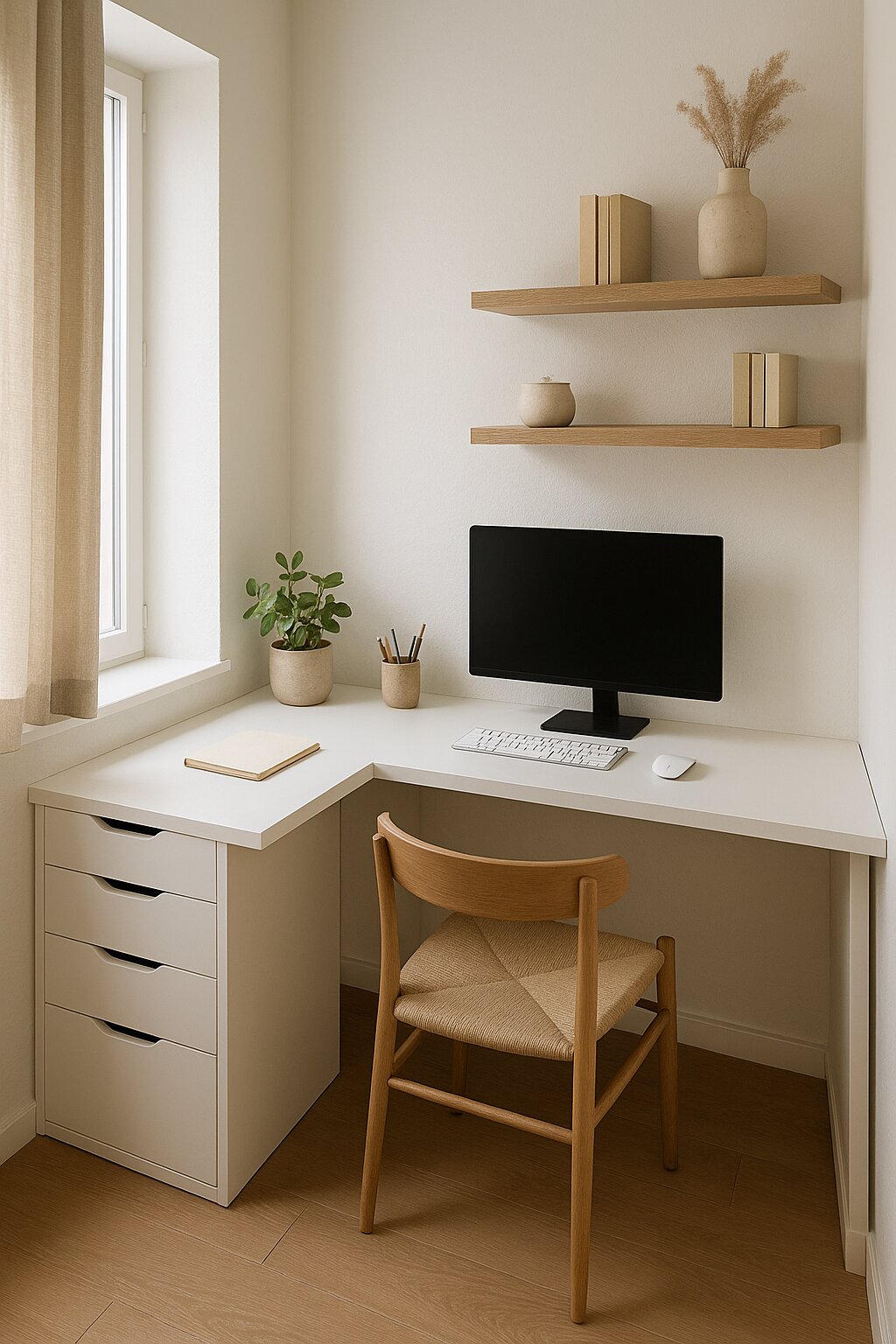
Maximize small space efficiency with a corner L-shaped desk layout that utilizes often-wasted corner areas while maintaining clean, minimal aesthetics. This practical configuration provides abundant work surface without occupying excessive floor space, perfect for compact apartments or multi-purpose rooms where the office must coexist with other functions. White walls and simple furniture keep the corner setup from feeling cramped or claustrophobic, while the L-shape naturally separates different work zones—computer work on one side, paperwork or creative projects on the other.
Corner arrangements also provide psychological benefits by giving you walls on two sides, creating a sense of enclosure and focus that open-plan desks sometimes lack. The efficient use of space embodies minimalist principles of thoughtful design and purposeful placement, ensuring every square foot serves a clear function. Keep the desktop clear and organized to prevent the generous surface area from becoming a catch-all for clutter that undermines your minimalist intentions.
PRO TIP: Mount floating shelves on the walls above your L-shaped desk to utilize vertical storage space without consuming additional floor area. This maximizes storage capacity within your compact footprint while maintaining the clean, streamlined appearance essential to minimalist aesthetics.
12. Soft Blush Pink Minimal Feminine

Create a feminine, gentle minimalist workspace with soft blush pink accents against a clean white and cream base palette. This delicate color brings warmth and personality without overwhelming the minimalist aesthetic or introducing visual complexity. The psychology of soft pink promotes calm, reduces stress, and creates a nurturing environment—valuable qualities for a workspace where you spend significant time and mental energy.
Blush pink works beautifully in minimalist contexts because its subtlety prevents it from dominating the space or creating visual noise; instead, it provides just enough color to feel warm and personal without compromising the clean simplicity. Incorporate pink through small, changeable elements—desk accessories, textile accents, artwork—so you can easily adjust if your color preferences shift over time. This approach maintains the neutral foundation while allowing personal expression through carefully edited color accents.
PRO TIP: Pair blush pink with brass or copper metallic accents rather than silver or chrome to maintain the warm, feminine aesthetic. The rosy-gold tones of copper perfectly complement blush pink while adding subtle luxury and sophisticated polish to your minimalist workspace.
13. Built-In Shelving Integration

Achieve ultimate minimalist organization with built-in wall shelving that integrates storage seamlessly into architecture rather than adding furniture that consumes floor space and visual attention. Custom built-ins provide precisely the storage you need without excess, following minimalist principles of thoughtful, intentional design tailored to specific requirements. The clean lines and integrated appearance make storage feel like part of the room itself rather than afterthought furniture pieces.
Built-in shelving allows you to display books, objects, and supplies in an organized, visually pleasing way that celebrates your possessions rather than hiding them away. The key to minimalist shelving is maintaining negative space—don’t fill every inch—allowing the architecture and remaining items to breathe and maintain visual calm. Group items by color, size, or category to create order and intention even within displayed collections.
PRO TIP: Paint built-in shelving the same color as walls to make them disappear architecturally and maintain visual simplicity, or paint them in a subtle contrasting tone to define and highlight the storage as an intentional design feature. Either approach can work beautifully depending on whether you want storage to recede or serve as subtle architectural interest.
14. Natural Light with Sheer Curtains

Maximize precious natural light with simple sheer white curtains that filter sunlight into a soft, diffused glow while maintaining privacy and visual simplicity. This approach to window treatment embodies minimalist principles by being both functional and beautiful without unnecessary complication or visual weight. The flowing fabric adds gentle movement and softness that balances harder architectural elements while the white-on-white color story maintains the cohesive, calm aesthetic.
Natural light is perhaps the most important element in any minimalist space, as it reveals materials’ true colors and textures while creating the bright, airy atmosphere that makes minimalism feel uplifting rather than stark. Sheer curtains provide the perfect compromise between open exposure and necessary privacy, filtering light rather than blocking it while softening window edges and adding subtle architectural detail. The simplicity of unlined sheers—no complex hardware, no fussy details—aligns perfectly with minimalist values.
PRO TIP: Hang sheer curtains as high as possible and as wide as your wall allows rather than simply covering the window frame. This creates the optical illusion of larger windows and higher ceilings while maximizing the fabric’s softening effect and maintaining clean, vertical lines that elongate the space.
15. Natural Rattan Accent Chair
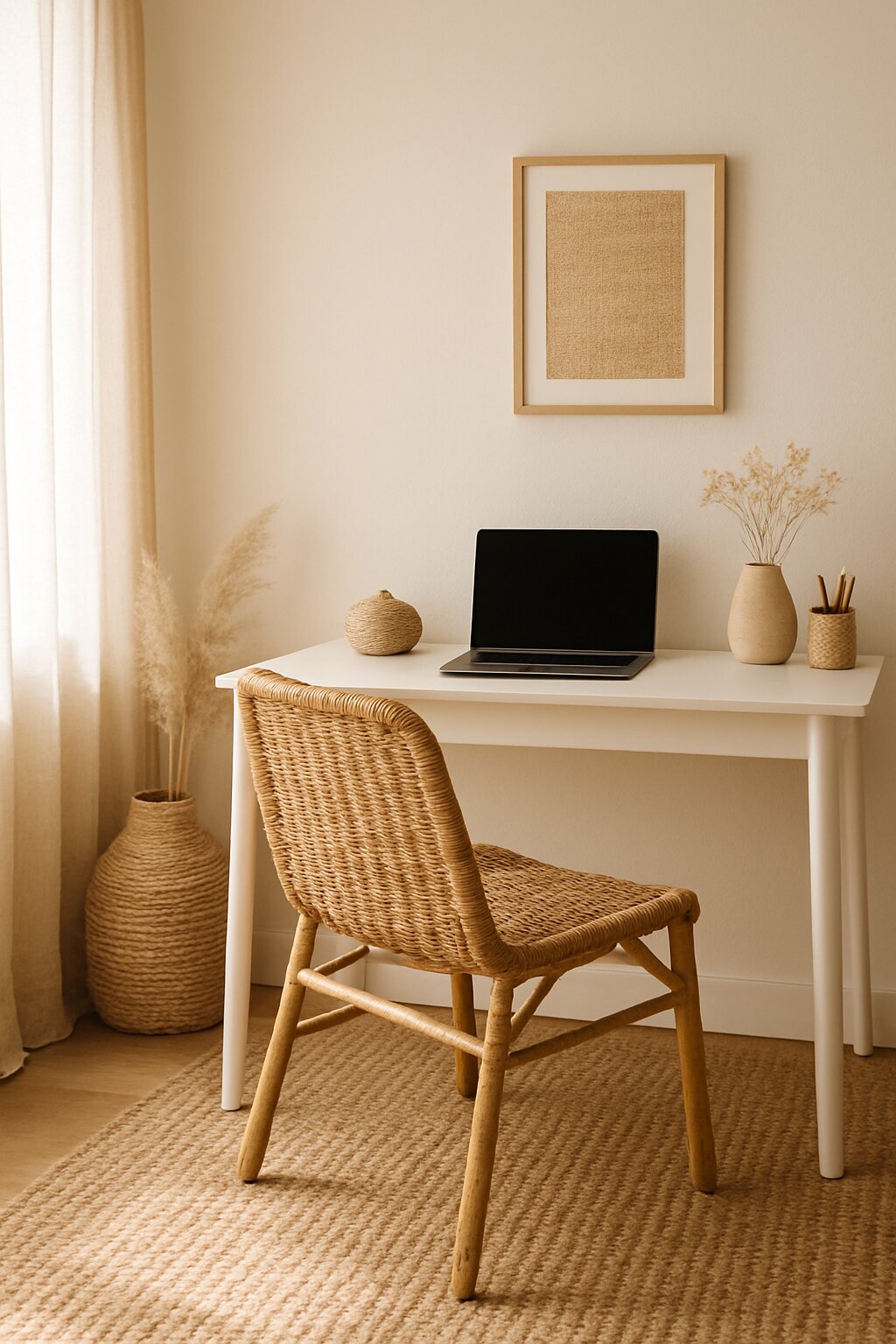
Add organic warmth and interesting texture to your minimalist office with a natural rattan or woven accent chair that provides both functional seating and sculptural beauty. The intricate woven pattern of rattan creates visual interest without introducing color or competing patterns, perfect for spaces where you want texture and dimension while maintaining simple aesthetics. Natural materials like rattan connect your workspace to nature and handcraft traditions, adding warmth that prevents minimalism from feeling cold or industrial.
A rattan chair can serve multiple purposes in a minimalist office—additional seating for visitors, a reading chair for contemplative breaks, or simply a beautiful object that adds character and personality to an otherwise spare space. The lightweight, airy quality of woven rattan aligns with minimalist principles of visual lightness and spatial openness. Position the chair near a window where natural light can highlight the intricate weave patterns and create interesting shadows.
PRO TIP: Add a simple cushion in natural linen or cotton to make your rattan chair more comfortable for extended sitting while maintaining the organic, minimalist aesthetic. Choose neutral colors that blend seamlessly with your overall palette rather than introducing new colors that fragment the calm, cohesive color story.
16. Wooden Pegboard Organization

Combine functional organization with minimalist aesthetics using a wooden pegboard wall system that keeps supplies visible, accessible, and beautifully arranged. This practical solution transforms storage into an intentional design feature, celebrating your tools and materials rather than hiding them in closed drawers or cabinets. The grid pattern of pegboard provides subtle visual structure and rhythm while the natural wood adds warmth that prevents the utilitarian system from feeling industrial or cold.
Pegboard organization embodies minimalist principles by keeping only what you actually use regularly within easy reach while removing unused items that merely create clutter. The visibility of pegboard storage also enforces ongoing minimalism—when you can see everything you own, you’re motivated to keep only what’s necessary and properly maintain what you keep. Arrange items by color, size, or category to create visual order and intentional composition that feels artistic rather than merely functional.
PRO TIP: Paint your pegboard and pegs all one color—either matching your wall for seamless integration or in a subtle contrasting tone for defined presence—to create cohesion and prevent the mix of tools and materials from appearing chaotic. Uniform color treatment provides visual calm that allows the organized items to shine without fighting their background.
17. Soft Blue and White Calming Palette
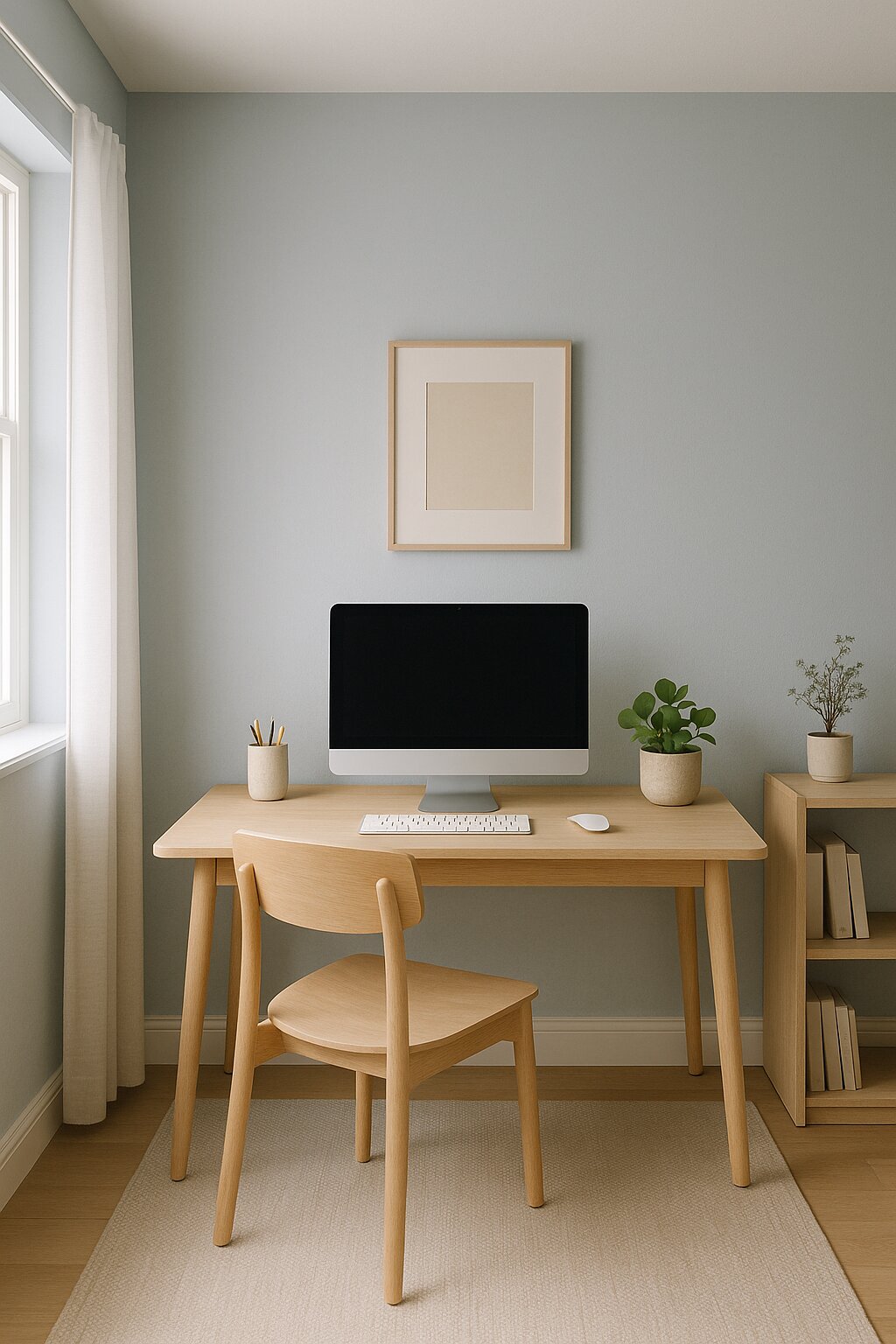
Create a peaceful, serene minimalist workspace with a soft blue and white color scheme that promotes calm, concentration, and mental clarity. Pale, muted blues have been proven to reduce stress, lower blood pressure, and improve focus—making this an ideal color choice for demanding mental work. The combination with clean white provides contrast and brightness while maintaining the cohesive, uncluttered feeling essential to minimalist design.
Soft blue feels naturally cool and receding, making spaces appear larger and more open than warm colors would in the same space. This color story works beautifully in offices with limited natural light, as blue reads well even in dimmer conditions and doesn’t appear muddy or dull like some warm neutrals can in low light. The association of blue with sky and water creates psychological connections to nature and openness even in windowless or urban spaces.
PRO TIP: Test blue paint colors throughout the day before committing, as blues can shift dramatically in different lighting conditions—appearing more purple, gray, or green depending on natural versus artificial light. What looks perfect at noon may read completely differently in morning or evening light in your specific space.
18. Single Modern Task Lamp
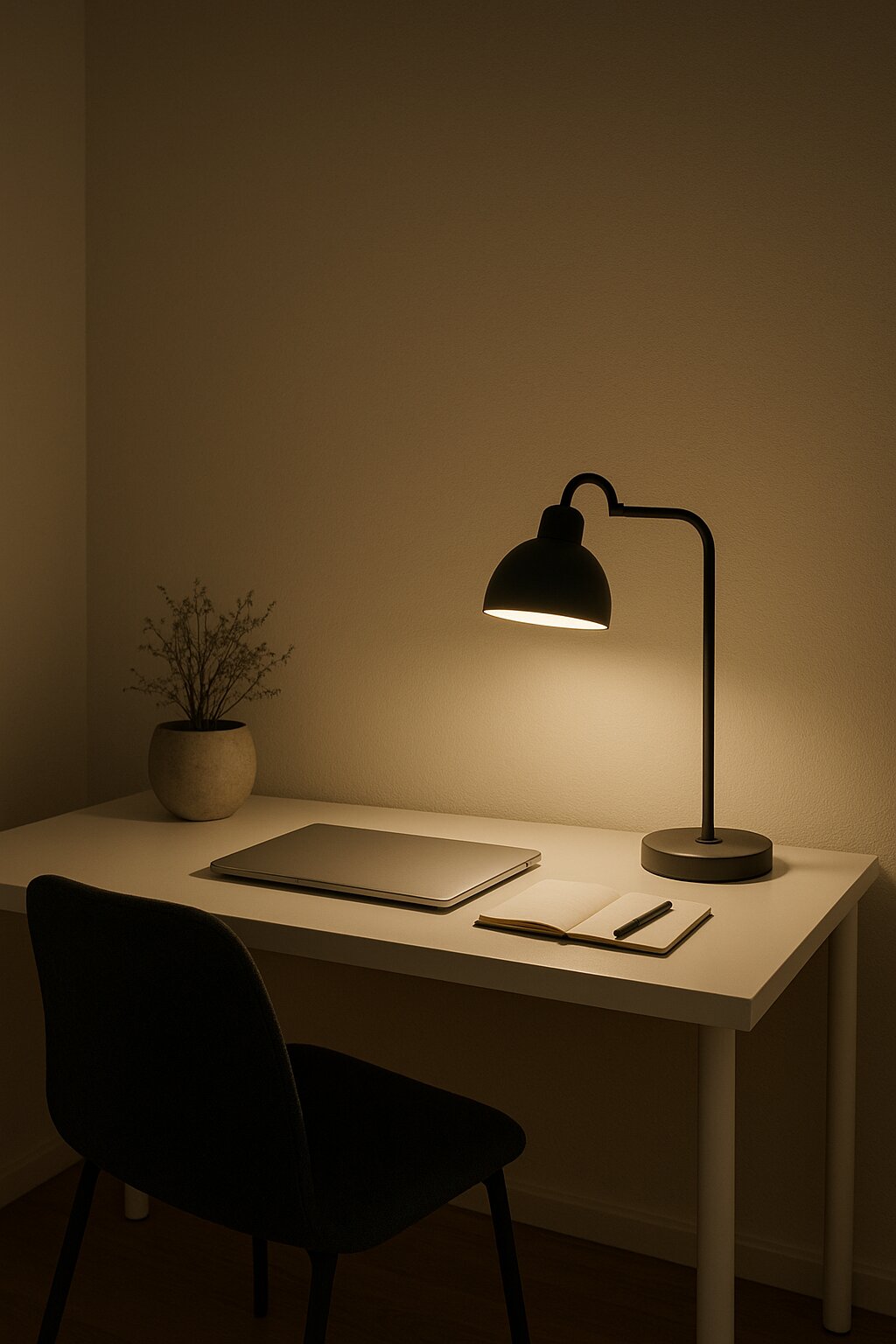
Embrace minimalist lighting design with one beautifully designed modern task lamp that provides focused illumination exactly where needed while serving as sculptural art when not in use. This approach rejects the idea that more lights equals better lighting, instead focusing on quality, intentional placement, and elegant design that enhances rather than clutters your workspace. A single exceptional lamp—whether mid-century modern icon, contemporary LED design, or architect-style classic—makes a stronger statement than multiple mediocre fixtures.
Focused task lighting allows you to illuminate your work surface precisely while keeping the rest of your space in softer, ambient light that reduces eye strain and creates depth and dimension. This layered lighting approach feels more sophisticated and intentional than harsh, even overhead lighting that flattens spaces. Choose a lamp with adjustable arm and head so you can direct light exactly where needed for different tasks throughout your day.
PRO TIP: Invest in a high-quality LED bulb with adjustable color temperature for your task lamp, allowing you to choose cooler, energizing light for daytime focus work and warmer, relaxing light for evening tasks. This flexibility maximizes the functionality of your single lighting source while supporting your circadian rhythms and changing needs.
19. Concrete and Warm Wood Mix
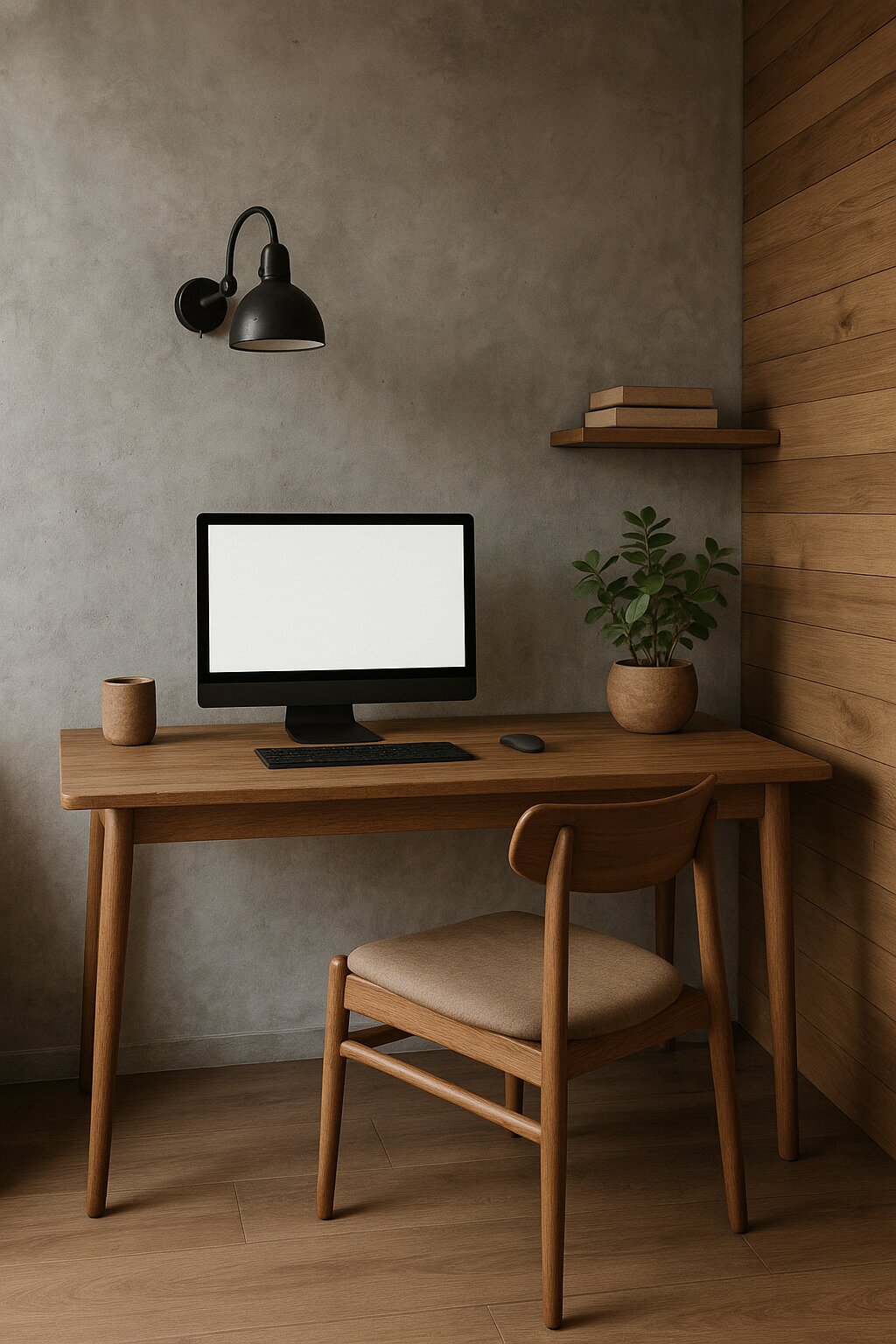
Create textural interest and balanced aesthetics by mixing industrial concrete elements with warm wood, combining two natural materials with opposing qualities that complement rather than compete. Cool, hard concrete provides architectural weight and contemporary edge while warm, organic wood softens and humanizes the space, preventing industrial materials from feeling cold or uncomfortable. This pairing creates a sophisticated, modern minimal aesthetic that feels current and design-forward.
The contrast between smooth concrete and textured wood grain creates visual and tactile interest without introducing pattern or color complexity, maintaining minimalist simplicity while avoiding blandness. Both materials celebrate honest, authentic surfaces rather than trying to pretend to be something else—concrete looks like concrete, wood looks like wood—which aligns with minimalist values of authenticity and truth in materials. The natural variations within each material provide subtle uniqueness that mass-produced finishes lack.
PRO TIP: Use concrete for horizontal surfaces like desktop or flooring where its durability and easy maintenance prove practical benefits, while using wood for vertical elements and items you’ll touch frequently. This strategic placement maximizes each material’s strengths while maintaining the balanced pairing throughout your space.
20. Single Abstract Artwork Focal Point
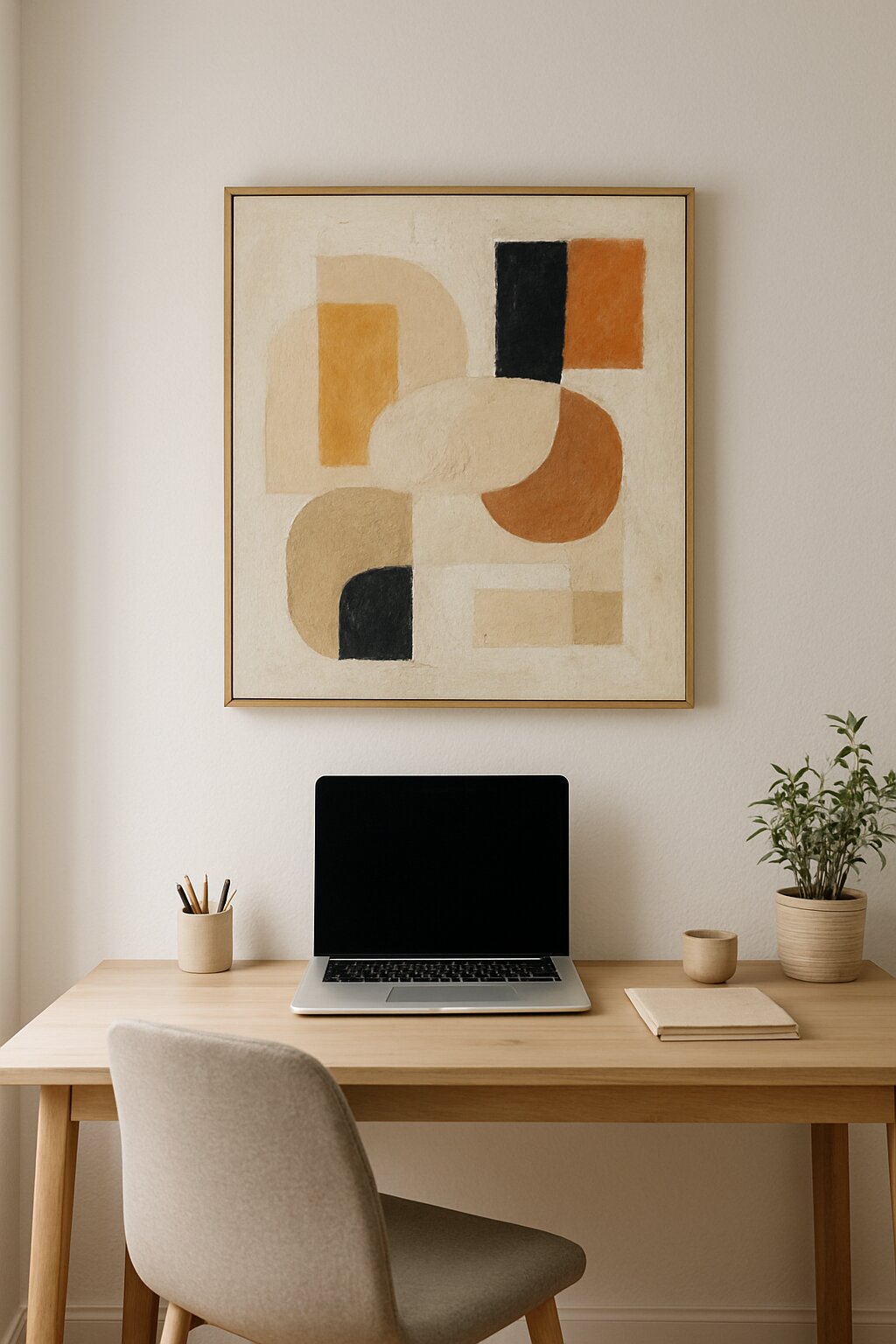
Let one piece of thoughtfully chosen abstract artwork serve as your office’s primary decorative element and focal point, proving that minimalism doesn’t mean empty walls or absence of personal expression. This approach demonstrates that less is more—a single meaningful artwork commands more attention and respect than a gallery wall of multiple pieces competing for notice. Abstract art works particularly well in minimalist spaces because its colors and forms can echo your palette while providing emotional impact and personal meaning.
The artwork you choose becomes a daily source of inspiration, meditation, or simply beauty that enriches your work environment without requiring additional styling or support. Position your artwork at eye level from your desk so it naturally enters your field of vision during contemplative moments, serving as a visual rest point during intensive work sessions. Choose a piece you genuinely connect with emotionally rather than simply matching your color scheme—authenticity matters more than perfect coordination in meaningful spaces.
PRO TIP: Frame your artwork simply in a slim, neutral frame that doesn’t compete with the art itself or introduce additional visual complexity. Clean, minimal framing allows the artwork to remain the focus while providing necessary protection and professional presentation that honors the piece.
21. Stone or Marble Accent Pieces

Introduce subtle luxury and natural beauty through carefully selected stone or marble accent pieces—perhaps a desk organizer, pen holder, or small sculptural object—that add weight and sophistication without overwhelming minimalist simplicity. These natural stone pieces bring geological time and natural artistry into your workspace, celebrating materials formed over millennia rather than manufactured yesterday. The cool, smooth surface of polished stone provides tactile pleasure and visual elegance that elevates everyday objects into something special.
Each piece of natural stone is genuinely unique with its own veining, color variations, and character—a quality that mass production can never replicate and that aligns beautifully with minimalist values of authenticity and material honesty. Stone’s substantial weight and solid presence create grounding stability in your workspace, both literally and psychologically. The neutral tones of most stone—whites, grays, blacks, beiges—integrate seamlessly into minimalist color palettes while adding dimension through natural pattern.
PRO TIP: Choose stone pieces with pronounced veining or distinctive pattern that showcase the material’s natural beauty rather than plain, uniform stone that could be mistaken for synthetic materials. The visible natural variation is what makes stone special and worth featuring in your minimalist space.
22. Open Airy Layout with Breathing Room
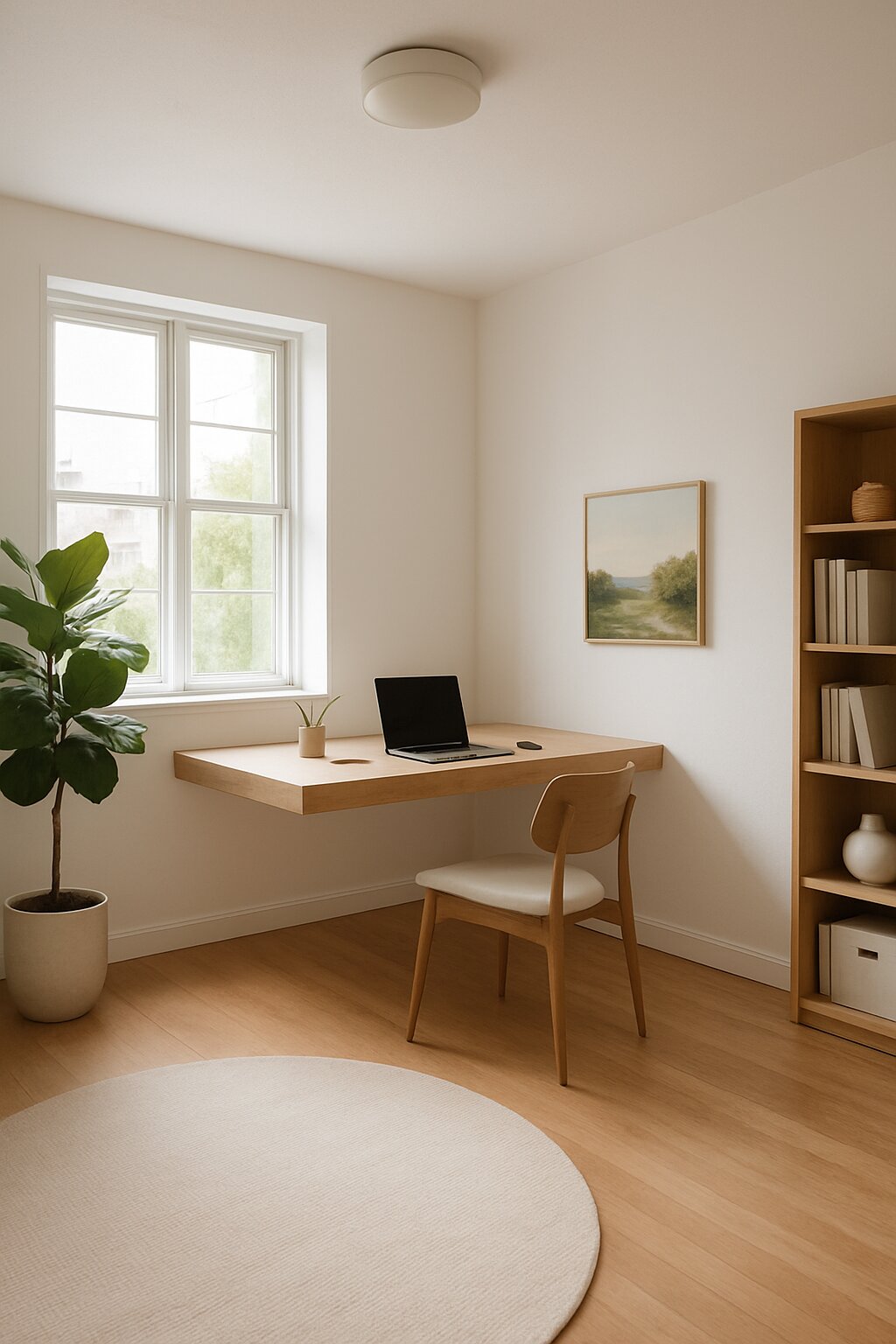
Prioritize generous negative space and breathing room in your office layout, resisting the urge to fill every corner or cover every surface. This fundamental minimalist principle recognizes that empty space isn’t wasted space—it’s essential psychological room that allows your mind to rest and focus to sharpen. An open, airy layout with a floating desk and minimal furniture creates freedom of movement and visual calm that cluttered spaces can never achieve, regardless of their style or budget.
The spaciousness of an uncluttered layout makes daily cleaning and maintenance dramatically easier, supporting your ability to maintain the minimal aesthetic over time rather than watching it gradually degrade into chaos. Open space also provides flexibility—you can easily reconfigure or adapt your workspace as needs change without being locked into a specific arrangement by too much furniture. The psychological effect of spaciousness shouldn’t be underestimated; humans generally feel more relaxed, creative, and capable in open environments than cramped, overcrowded ones.
PRO TIP: When arranging furniture, create clear pathways and ensure you can walk completely around your desk without squeezing or turning sideways. This functional test ensures your “breathing room” is genuine spatial comfort rather than merely aesthetic minimalism that becomes inconvenient in daily use.
23. Brass Hardware Accent Details

Add refined sophistication through brass hardware and metallic details—drawer pulls, lamp base, desk accessories—that catch light and provide warm metallic shine without introducing color complexity. Brass’s warm gold tone complements virtually any color palette while adding a touch of luxury and polish that elevates minimalist spaces from spare to sophisticated. The metal’s natural tendency to develop patina over time actually enhances character rather than degrading appearance, aligning with minimalist appreciation for materials that age gracefully.
Small metallic accents throughout your space create visual cohesion and intentional repetition that makes the design feel thoughtfully composed rather than arbitrarily assembled. Brass provides enough visual interest and light reflection to prevent all-white or neutral minimalism from feeling flat or boring while maintaining the clean simplicity essential to the aesthetic. The warm metallic tone bridges cool and warm elements in your space, creating harmony between potentially competing temperatures.
PRO TIP: Embrace the natural patina that brass develops rather than constantly polishing it to mirror brightness. The aged, slightly tarnished appearance adds character and authenticity that fits perfectly with minimalist values of natural materials behaving honestly rather than being forced to maintain artificial perfection.
24. Single Natural Fiber Rug Accent

Ground your minimalist workspace with a single natural fiber rug in jute, sisal, or seagrass that adds textural warmth and subtle pattern while maintaining neutral tones and organic simplicity. This practical layer provides comfortable footing, reduces noise in hard-surfaced rooms, and defines your office zone in open-plan spaces without introducing color or visual complexity. The natural weave creates subtle texture and dimension that prevents floor areas from feeling flat or unfinished while the neutral tone blends seamlessly with minimalist aesthetics.
Natural fiber rugs align with minimalist values of sustainable, renewable materials that are biodegradable and low-impact rather than synthetic. The organic imperfections and slight color variations within natural fibers add authentic character that factory-made materials lack. These rugs are also remarkably durable and practical for high-traffic office spaces, aging gracefully rather than showing wear in unattractive ways.
PRO TIP: Choose a rug size large enough that your desk and chair remain entirely on the rug even when pushed back, preventing the annoying situation where chair wheels catch on rug edges or you roll off onto hard floor. This functional consideration ensures your aesthetic choice remains practical in daily use.
25. Ladder Shelf Minimal Display

Incorporate a leaning ladder shelf for minimalist open storage that displays carefully curated items while maintaining visual lightness and flexible positioning. This Scandinavian-inspired storage solution provides shelving without the visual weight of traditional bookcases, maintaining the open, airy feeling essential to minimalist spaces. The angled lean creates interesting architectural lines while the open shelves ensure everything stored remains visible, encouraging mindful curation of only truly valued items.
Ladder shelves can be easily repositioned as needs change, don’t require mounting or installation, and create less commitment than built-in storage—perfect for renters or anyone who values flexibility. The open construction allows light to pass through rather than creating dark, heavy visual barriers that fragment space. Display books, plants, and meaningful objects in an intentionally sparse arrangement that celebrates each item rather than cramming shelves full.
PRO TIP: Style your ladder shelf with the “rule of odds”—groups of three or five items look more interesting and intentional than even-numbered groupings. Leave some shelves completely empty to maintain the breathing room and negative space that makes minimalism feel calm rather than merely sparse.
26. Hidden Storage Solutions
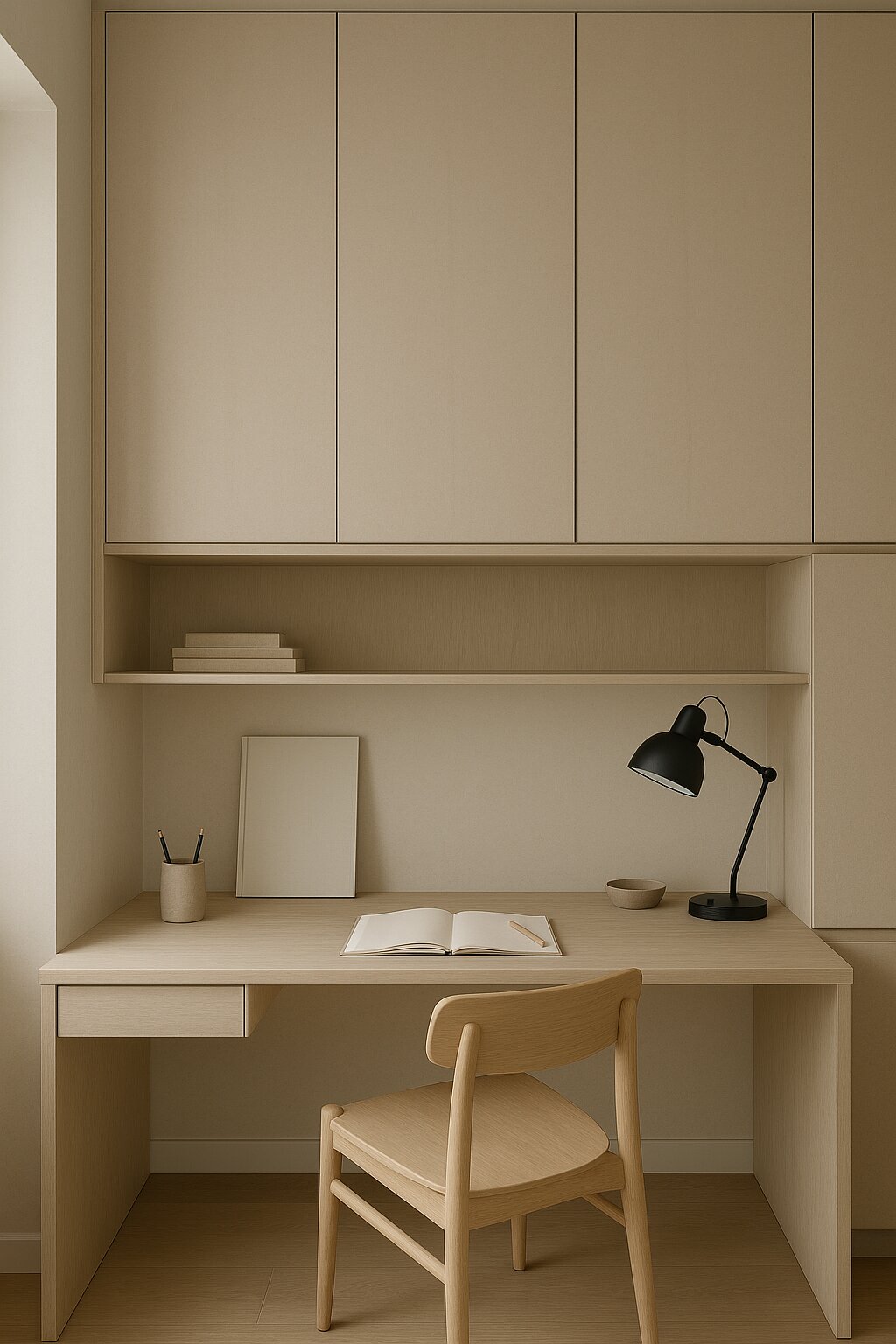
Achieve truly clutter-free surfaces through hidden storage solutions—concealed cabinets, drawers built into desks, storage ottomans—that keep necessary items accessible while maintaining the clean, minimal aesthetic of empty surfaces. This approach recognizes that minimalism doesn’t mean owning nothing; it means thoughtfully containing what you own so visual space remains calm and uncluttered. Integrated storage allows your workspace to function efficiently while looking serene and intentional.
Hidden storage requires more initial planning and potentially higher investment than open shelving, but the psychological benefit of clean surfaces and organized spaces provides daily value that justifies the effort. When everything has a designated, concealed home, maintaining minimal order becomes effortless rather than constant struggle. The key is ensuring hidden storage remains logical and accessible so you actually use it rather than resorting to visible clutter out of convenience.
PRO TIP: Label interior drawers and concealed storage areas so you remember what’s where without opening everything to search. This practical step ensures your hidden storage system remains efficient and functional rather than becoming a confusing catch-all that defeats its organizational purpose.
27. Paper Lantern Soft Ambient Lighting
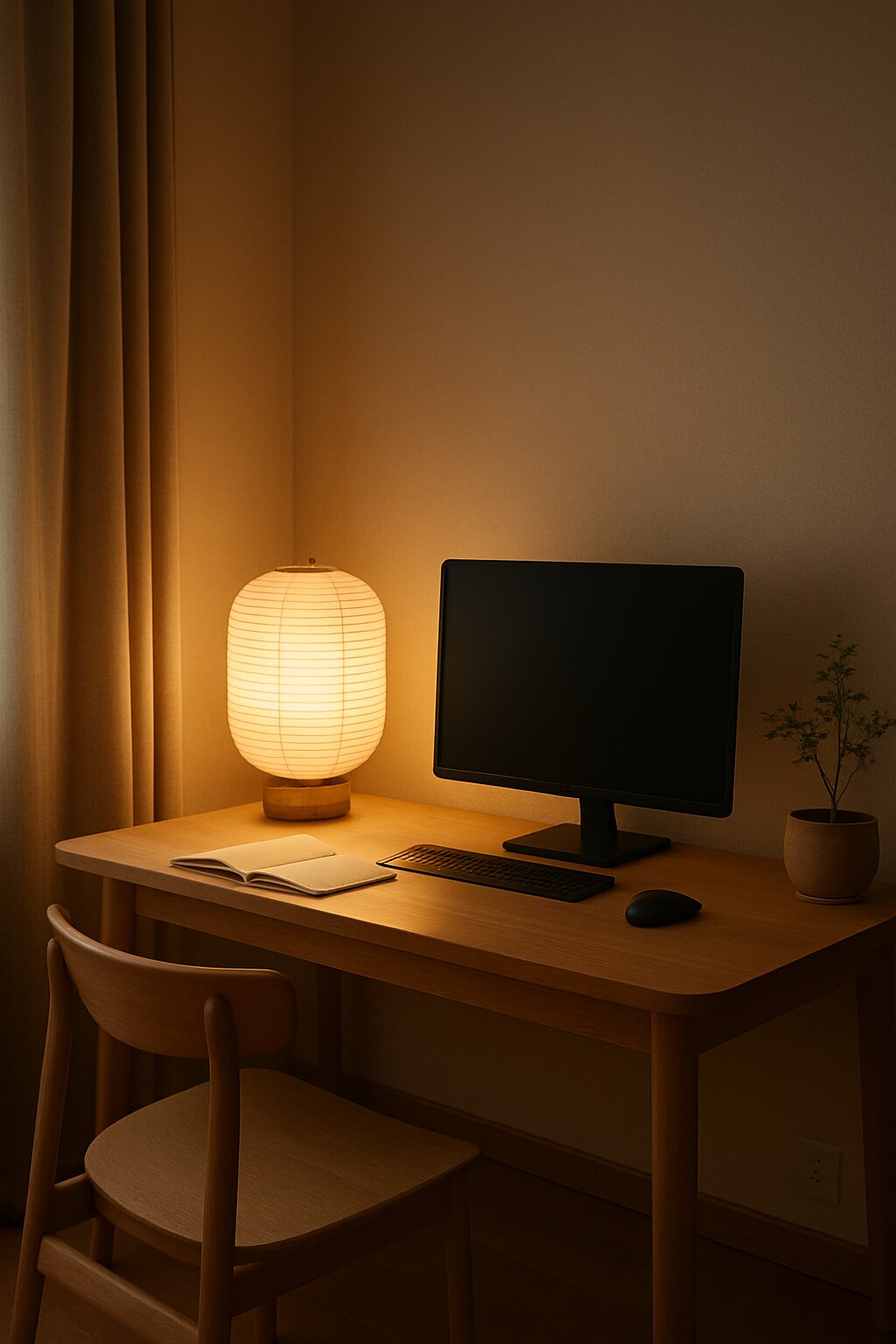
Create peaceful, diffused lighting with a Japanese paper lantern or similar soft ambient light source that provides gentle illumination without harsh glare or visual complexity. These simple, sculptural light fixtures embody minimalist principles through their clean spherical or cylindrical forms, neutral white color, and soft, even light distribution. The rice paper or fabric diffuser transforms bare bulbs into glowing orbs that feel meditative and calming while providing functional illumination.
Paper lanterns add vertical interest and subtle architectural presence without the visual weight of traditional chandeliers or the harshness of exposed bulbs. The soft, shadowless light they create reduces eye strain and creates a peaceful atmosphere particularly valuable during evening work sessions. Multiple lanterns in varying sizes can be hung at different heights to create layered lighting that adds dimension while maintaining minimalist simplicity and cohesion.
PRO TIP: Install dimmer switches for paper lantern fixtures so you can adjust light levels throughout the day based on natural light availability, time of day, and task requirements. This flexibility maximizes the functionality of your simple lighting while supporting your natural circadian rhythms through adjustable brightness.
